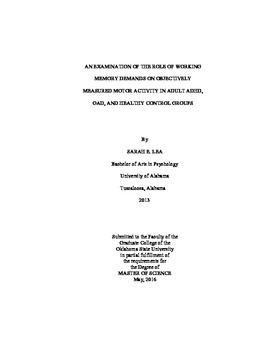| dc.description.abstract | Attention-deficit/hyperactivity disorder (ADHD) is a complex neurocognitive disorder characterized by problems with attention, hyperactivity, and impulsivity. While previously considered a childhood disorder, recent research indicates that currently 4 to 5% of the adult population meets diagnostic criteria for ADHD. Furthermore, the presence of ADHD in adulthood has been associated with a number of negative outcomes such as a lower socioeconomic status, increased risk for substance abuse, traffic violations, and workplace difficulties. Hyperactivity is the primary reason for clinical referrals and is an important symptom in distinguishing ADHD subtype classifications. Additionally, hyperactive behaviors are associated with the most severe lifelong impairment due to their disruptive nature. Most notably, excessive hyperactive behavior is predictive of criminal activity in adulthood. The functional WM model of ADHD suggests that biological factors such as genetics influence the neurobiological system of WM and result in impaired CE functioning and a limited storage capacity in the PH and VS systems. In turn, these impairments lead to deficits in basic learning and attention abilities. Moreover, excessive levels of motor activity serve as a compensatory strategy to increase cortical arousal need to improve WM performance and to meet the environmental demands on central executive (CE) functioning. Notably, excessive motor activity such as restlessness and fidgeting are not pathognomonic symptoms of ADHD, and are often associated with other problems of psychopathology. For example, the diagnostic criteria of Generalized Anxiety Disorder (GAD) includes restlessness as a distinguishing symptom of the disorder. Furthermore, previous research indicates WM deficits in storage and rehearsal components directly affect ruminations or anticipatory processing associated with anxiety disorders. The topographical similarity of excessive motor activity seen in both ADHD and anxiety disorders, as well as similar WM deficits, may indicate a common relationship between WM deficits and increased motor activity across psychopathology. However, to date, no studies have examined the possible relationship between WM deficits and objectively measured motor activity associated with anxiety. Consequently, the current study examined objectively measured motor activity associated with the WM system in adults with ADHD, adults with GAD, and healthy control (HC) adults. | |
